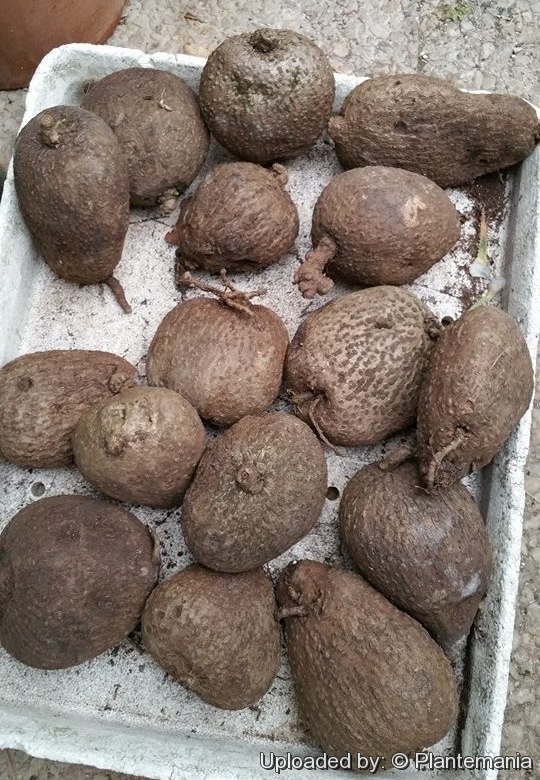
Stephania cephalantha Photo by: © Plantemania
Origin and Habitat: Eastern Asia - southern and central China (Anhui, Fujian, Guangdong, Guangxi, E and S Guizhou, Hubei, Hunan, Jiangsu, Jiangxi, Shaanxi, Shanxi, E and S Sichuan, Taiwan, Zhejiang).
Habitat and ecology: Stephania cephalanthaSN|33641]]SN|33641]] grow in village margins, open fields, and forest margins. It is a plant mainly of subtropical China, but entering into the Tropics in the south of its range.
Synonyms:
See all synonyms of Stephania cephalantha
back
Accepted name in llifle Database:Stephania cephalantha HayataIcon. Pl. Formosan. 3: 12, sphalm. cepharantha. 1913 [25 Dec 1913]Synonymy: 3
back
Common Names include:
CHINESE (中文): 金钱调乌龟, jin qian diao wu gui
Description: Stephania cephalanthaSN|33641]]SN|33641]] is a herbaceous, perennial climbing plant (vine) producing stems up to 2 metres long from a tuberous rootstock that can be 20 cm or more wide.
Rootstock: Tuberous, sometimes irregular, up to 20 cm or more wide, brown, with many projecting lenticels.
Branches: Slender, herbaceous, grooved longitudinally, and glabrous, usually 1-2 metres or longer. The climbing mode is twining and dextrorse stems. The branchlets are slender, purplish red.
Leaves: Glabrous thinly herbaceous, membranous or papery, blade rounded-triangular, 2-6 cm long, 2.5-6.5 cm wide, paler underneath, apex obtuse mucronate, base rounded, truncate, or peltate, margins entire or somewhat undulate, palmately 7-9-nerved, longly petiolate. Petiole1.5-7 cm long, very slender and glabrous.
Flowers and infloresceces: Capitulate, the capitula (flower heads) clustered in panicles (± 19-20 per panicle). Male inflorescences solitary, very slender, often axillary, 7-8 cm long. Peduncles slender 1-2 mm long, base 1-bracteate, bracts oblong-triangular, 1.5 mm long, 1 mm wide. Stem of the raceme and peduncles of the capitula on the same plane. Heads disc-like, round, 6 mm in diameter, receptacles peltate to 4 mm in diameter. Sepals 4 or 6 (or 8), linear-spathulate, 1-1.5 mm long, 0.5 mm wide. Petals 3 or 4(-6), fleshy rounded or broadly obovate, ca. 0.5 mm long. Stamens 2-6, united in a stalked disk (synandrium) shorter than sepals. Female inflorescences similar, solitary and axillary, peduncle thicker, 1-2 cm. Sepals 1 or 2, occasionally 3(-5), approx. 0.8 mm or longer. Ppetals 2(-4), fleshy, smaller than sepal.
Fruits (drupes): Red, broadly rotund, ± 6.5 mm in diameter.
Phenology: Flowering late-spring ( Apr-May). Fruiting summer (Jun-Jul.).
Bibliography: Major references and further lectures
1) Stephania cephalantha Hayata: Hayata, B., "Icones plantarum formosanarum", vol. 3: p. 12, fig. 4 (1913)
2) Stephania cephalantha in: "Flora of China" FOC Vol. 7 Page 16, 22. Website http://flora.huh.harvard.edu/china/ , Missouri Botanical Garden Press; St. Louis.1994
3) "Medicinal Plants of the Philippines" Website http://www.bpi.da.gov.ph/Publications/mp/mplants.html Bureau of Plant Industry, Philippines.
4) "Bihrmann's Caudiciforms" Website http://www.bihrmann.com/caudiciforms/
5) Duke. J. A. and Ayensu. E. S. "Medicinal Plants of China" Reference Publications, Inc.1985
6) Ken Fern 2014 , "Useful Tropical Plants Database" Last update on 2017-01-08: http://tropical.theferns.info/viewtropical.php?id=Stephania+cephalantha .
7) Sheng-Zehn Yang, Po-Hao Chen “Cambial Variants in the Family Menispermaceae in Taiwan” American Journal of Plant Sciences Vol.07 No.06(2016).
Cultivation and Propagation: Stephania cephalanthaSN|33641]]SN|33641]] grows best in a moist but well-drained, humus-rich soil and prefers a position in full sun to moderate shade.
Traditional uses: The plant is often used in traditional Chinese medicine, for which purpose it is generally harvested from the wild. The tuber is analgesic, diuretic. It is used in the treatment of epilepsy and tuberculosis. The tuber contained the alkaloid cepharanthine, which is said to be of low toxicity and very effective against tuberculosis infection in various parts of the body. A single, strong dose is said to cure whooping cough.










